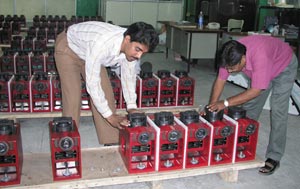
The first 800 jacks for one sector of the Large Hadron Collider (LHC) have arrived at CERN from India in recent weeks. After the final acceptance of the pre-series jacks at the end of October, they can now be used to support the LHC superconducting magnets. The jacks are designed to adjust the positions of the magnets, which weigh more than 32 tonnes, with an accuracy of one-twentieth of a millimetre. This is equivalent to moving the weight of eight Indian elephants by the breadth of a human hair.
The 80 kg jacks were designed by the Centre for Advanced Technology (CAT) in India and are being built by Avasarala Automation in Bangalore and the Indo-German Tool Room in Indore. The close collaboration between CAT, the Department of Atomic Energy in India and CERN began in 1996, and the first two batches of jack prototypes were delivered to CERN in November 2000. These prototypes, which are still supporting the test strings in hall SM18, were used to test the manufacturing principles and design of the jacks. Supporting all the superconducting magnets (dipoles and quadrupoles) of the LHC will require 7000 jacks, which are being continuously delivered to CERN up to mid-2005.
The jacks consist mainly of a central column of variable height supported on spherical bearings at each end so the column can be tilted. Each dipole rests on three jacks (and another special type for fine corrections), and can be positioned and adjusted with very high precision in all three dimensions. After acceptance of the pre-series, the road is clear for the jacks to be used to support the LHC magnets.








